Dell U3011 Review: Dell's New 30-inch Flagship
by Brian Klug on January 13, 2011 9:17 PM ESTViewing Angles
The U3011 has superb viewing angles, just like we've grown accustomed to seeing from IPS panels. Even at the far extreme horizontally, there's none of the purple I'm used to seeing from TN panels as you move off-axis. In the vertical direction, I saw the same thing with almost nothing to complain about. I did notice some glare at the extreme angles, but again that's dependent on where you're sitting and where light sources are located.
I think this is an excellent opportunity to talk about IPS graininess, something we really haven't discussed before. Of the IPS panels I've used to date, all of them have had some high frequency grain on the surface from a combination of coating and interference at the interface. Thankfully the U3011 has a combination antireflection coating and hard coating, and subjectively there seems to be less grain than I've seen on other displays.
Color Quality
Next up are the ever-important color quality metrics. As usual, we report two main quality metrics: color accuracy (Delta-E) and color gamut. Color gamut refers to the range of colors the display is able to represent with respect to some color space. In this case, our reference is the AdobeRGB 1998 color space, which is larger than the sRGB color space. Our percentages are thus reported with respect to AdobeRGB 1998, and larger is generally better unless you're dealing with sRGB content and colorspace-unaware software.
Color accuracy (Delta E) refers to the display’s ability to display the correct color requested by the GPU and OS. The difference between the color represented by the display, and the color requested by the GPU is our Delta-E, and lower is better here. In practice, a Delta E under 1.0 is perfect - the chromatic sensitivity of the human eye is not great enough to distinguish a difference. Moving up, a Delta E of 2.0 or less is generally considered fit for use in a professional imaging environment - it isn’t perfect, but it’s hard to gauge the difference. Finally, Delta E of 4.0 and above is considered visible with the human eye. Of course, the big consideration here is frame of reference; unless you have another monitor or some print samples like a Gretag Macbeth color checker card to compare your display with, you might not notice.
As I mentioned in our earlier reviews, we’ve updated our display test bench. We’ve deprecated the Monaco Optix XR Pro colorimeter in favor of an Xrite i1D2 since there are no longer up-to-date drivers for modern platforms. We're trying to find an i1Pro to use as well.
For these tests, we calibrate the display and try to obtain the best Delta-E we can get at both 200 nits of brightness for normal use, and 100 nits for print brightness. We target D65 and a gamma of 2.2, but sometimes the best performance lies at native temperature and another gamma, so we try to find what absolute absolute best-case performance for each display. We also take an uncalibrated measurement to show performance out of the box using either the manufacturer supplied color profile, or a generic one with no LUT data. For all of these, dynamic contrast is disabled, and displays are left to settle for a half hour after making changes. The U3011 is CCFL-backlit, and I used a settle time of 30 minutes accordingly.
First up is uncalibrated Delta-E performance. For this test, I took the monitor out of the box, connected it over DisplayPort, adjusted to 200 nits, and ran our usual GMB color checker test. Results aren't that great, sadly.
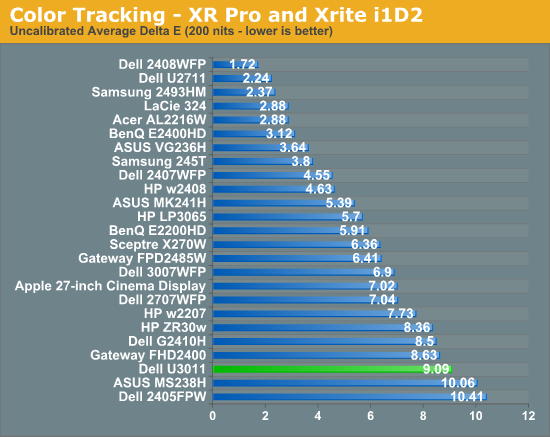
I mentioned earlier that the U3011 we got from Dell for testing came with no factory calibration report. After checking up with them, we learned this is a pre-production unit identical to what's shipping now, minus that factory calibration. That's something we can live with, especially since we recommend every display be calibrated, but still unnerving.
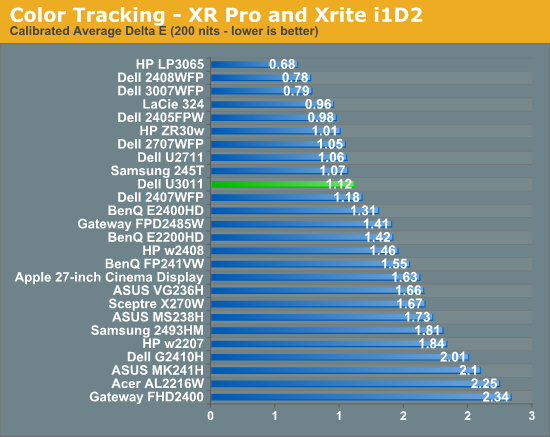
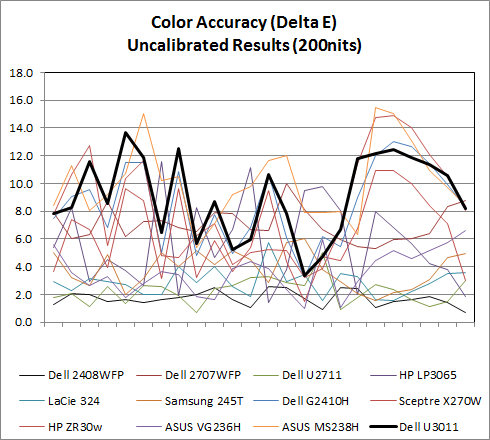
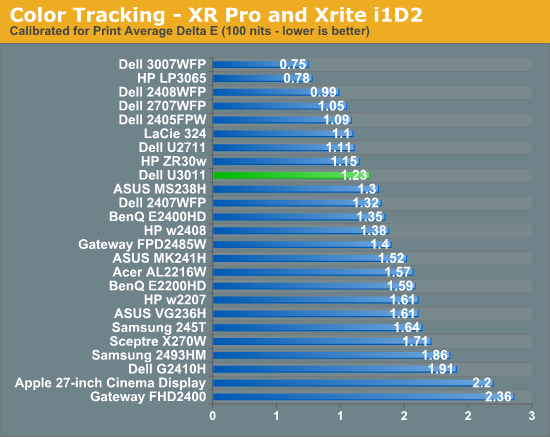
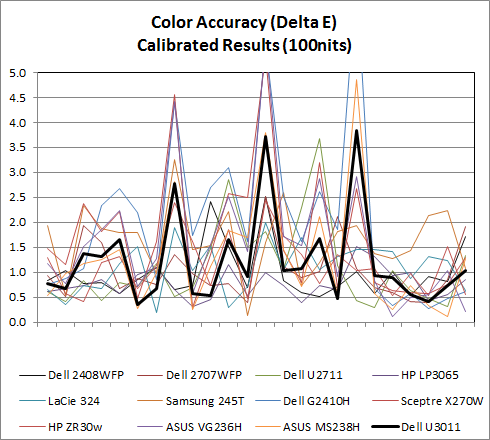
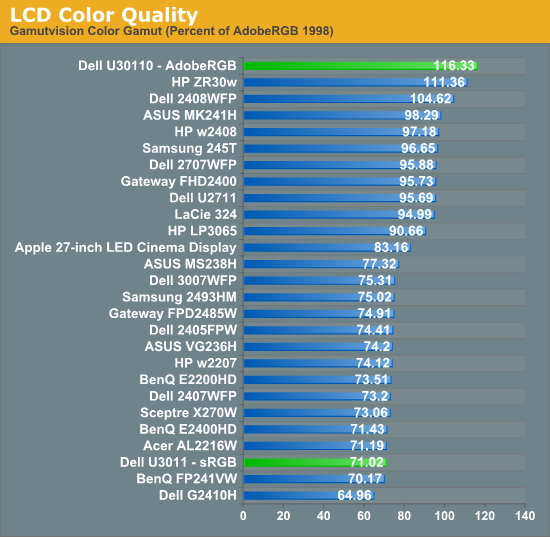

AdobeRGB Mode
sRGB Mode
Calibrated Delta-E is very good, though I'm still surprised the U3011 can't get under 1.0 on our tests. I'm starting to suspect that our i1D2 isn't quite as good as the Monaco Optix XR Pro, and have started looking for an i1Pro spectroradiometer as a result so we can have something more accurate going forward. That said, performance is still more than adequate for professional work. These two calibrations were performed in the sRGB mode at D65.
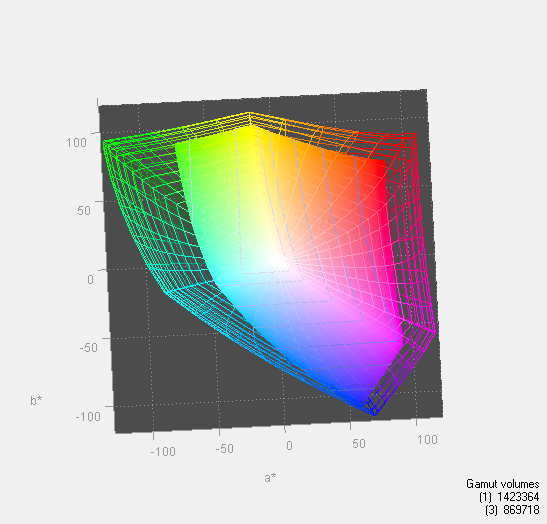
In addition, the U3011 has modes for AdobeRGB color space and sRGB in the OSD, something extremely useful for doing work and not getting oversaturation in applications that lack color management. You can immediately see the effect of those two modes in the color gamut measure above. Letting the monitor free to use its entire gamut of color, it leads the pack. Turn sRGB mode on, and it clamps down just nicely. 116.33% is also shockingly close to Dell's advertised 117% coverage of CIE 1796 (AdobeRGB), which is awesome to see confirmed above.








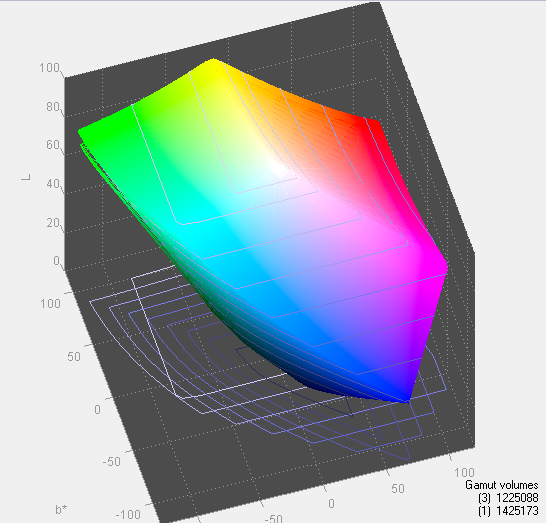
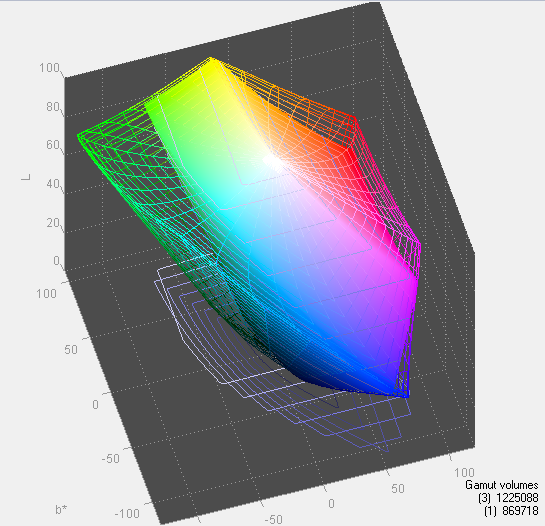








123 Comments
View All Comments
erple2 - Friday, January 14, 2011 - link
Perhaps. Though you don't need to upgrade to astronomical levels - I bought an HP 2475w (24", IPS 1920x1200) that sits right next to my trusty Dell 2001FP. What's particularly nice is the vertical rez is the same in each monitor. The HP was around 600 when I bought it, but still very nice. Color consistency is a bit better, and brightness is certainly better, but they're calibrated to about the same level.Granted, that does nothing to address whether you want more vertical resolution (which ultimately, as a programmer, is what I wanted).
Nothing will ever be perfect out there, BTW. Just get something that is "good enough" that doesn't cost an arm and a leg.
DanNeely - Friday, January 14, 2011 - link
The NEC 3090 is a 2006 (07?) design. I can't find it but I suspect the -R model you found for $1400 is a refurb (I bought one when they sold a batch for $1000ish a year ago). The standard model is still $2200, the pricier -SV model just bundles a colorimeter and their hardware calibration software into the package.GTaudiophile - Friday, January 14, 2011 - link
Here is that -R model:http://www.necdisplay.com/Products/Product/?produc...
DanNeely - Saturday, January 15, 2011 - link
It's a refurb. You can tell because of the refurb Q&A link in the sidebar, and can confirm by going to the refurb section of their store. That said, NEC replaces teh backlight of their refurbs, and since the backlight is the part most likely to fail you've got almost everything you'd get from a new monitor except the extended warranty.philosofa - Friday, January 14, 2011 - link
to your opening paragraph Brian. The lack of progress is frustrating as hell, there are a mix of interesting techs, but they're all tied up within their own (1080p for the most part) worlds. At the end of the day this is a less 'spec driven' market due to the lack of opacity for most people of the technology involved, but the effects are sad and very transparent.I'm still stuck on a Samsung 2443 BW, I would love the colour improvement LED brings, and moreover I'd love as a gamer to have a 120Hz screen - but what I really dream of is a ~27", IPS, low input lag, 2560x1440, 120Hz LED backlit monitor. I'd be willing to pay for it, (or even perhaps a 2048x1152 ~24" variant) but all the dramatic improvements I see seem to be stuck in 1080p, and mutually exclusive of each other.
Grr - as you say, this is in stark contrast to the CPU and GPU markets. 2443 it is then, for the time being.
philosofa - Friday, January 14, 2011 - link
Amed = Amen ;) A very hearty one at that lol. Damn G19 (OMG look my KB pixel density is higher than my monitor's!)Belard - Friday, January 14, 2011 - link
I myself don't care much for all these 1080 monitors out there for todays 23~27" monitors. I have one of the last Samsung 24" 1920x1200 screen. I still don't care much for the EXTRA-WIDE screen we have today.When it goes... I too would love to have a 26~27" which 2560x1440, the text and everything should look crisp!
DarkUltra - Sunday, January 23, 2011 - link
Isn't it low-screen instead of extra wide? 24" 1920x1200 is just as wide as 23" 1920x1080. Ya text is really nice at high DPI, check out the latest smartphones next time you are out shopping electric appliances.erple2 - Friday, January 14, 2011 - link
Do the LED screens really have "better" color reproduction? I thought that was only true with the ultra-expensive multicolored LEDs, like the Eizo $3000+ dollar monitors, or the "HP Dreamcolor 2480" type displays?Pylon757 - Saturday, January 15, 2011 - link
Unless it's RGBLED, I heard it's worse than CCFL at times because white LEDs are missing some parts of the spectrum.